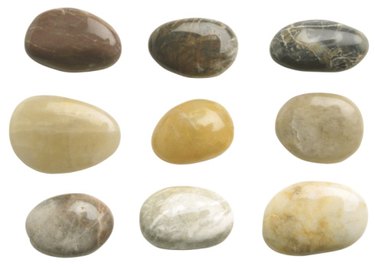
Rocks or stones are solid materials made up of minerals found in nature. Rocks are widely used in construction, but may also be collected or used in crafts projects. You can dye rocks and turn them into pendants or decorative pieces. Soapstone is ideal for dyeing or staining, because it is porous and absorbs paints easily. However, marble, limestone or gemstones may also be painted. The techniques you use to add color to rocks may depend on the porosity of the materials you paint or your personal preferences.
Brush Painting
Video of the Day
Brush painting is the simplest and least expensive technique to add color to rocks. Use brush painting on rocks that have a higher degree of absorbency and are more porous. However, you can also use brush painting on rocks with a lower porosity ratio, but you need to sand and prime the surface before applying the paints to ensure these adhere to the surface. Both water-based and oil paints can be suitable for dyeing rocks, and this allows you to create different motifs and add details to the painted surface. Apply a varnish to add luster to the rock or seal the rocks with wax to protect the colors.
Video of the Day
Airbrushing
Airbrushing is a painting technique that uses a small tool known as an airbrush. Inks or dyes can be used with this technique and they are mixed with glue to ensure the colors stick to the surface. Spray the colors on the surface and create a uniform coat of color. Use chalk to trace a design and use several colors on your rocks. This technique may be used for any types of rocks, and is ideal for marble or other rocks that have a lower porosity ratio.
Natural Vegetable Oil Dyeing
The dyeing with natural vegetable oils is a traditional technique of enhancing colors on rocks such as gemstones. Cedar wood oil and linseed oil are most commonly used and are mixed with color, which is typically a natural pigment. This technique is often used as a fracture filler in emeralds, rubies and quartz. The rocks are painted and coated or impregnated with wax, which protects the color and makes it more durable.
Heating
Dyeing rocks through heating is a technique that is used to enhance the appearance of gemstones. Initially, the stones are colored with oil or water-based dyes and the stones are heated, so the solvent of dyes evaporate. After the heating, which stabilizes the colors, a thin layer of color remains on the stones or in the cracks and pores of the materials that are dyed. Chalcedony, quartzite, opals and corundum are often dyed using this technique.